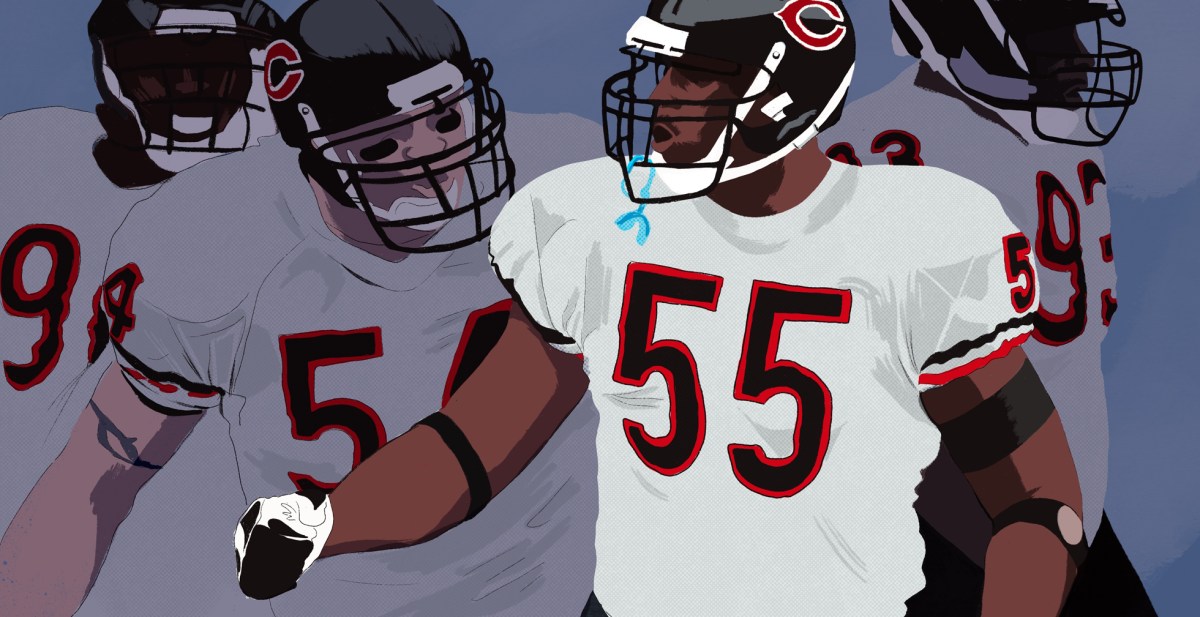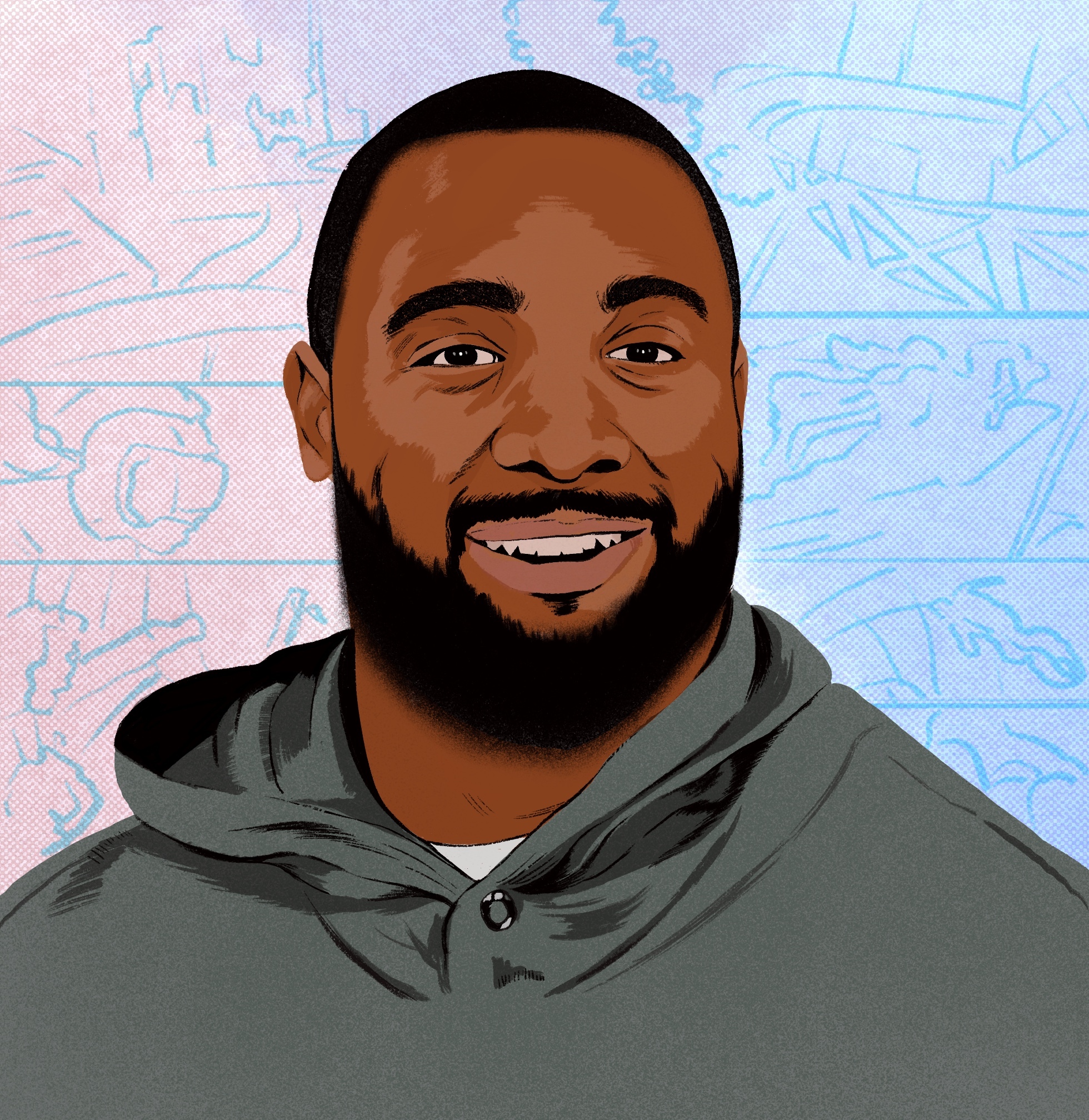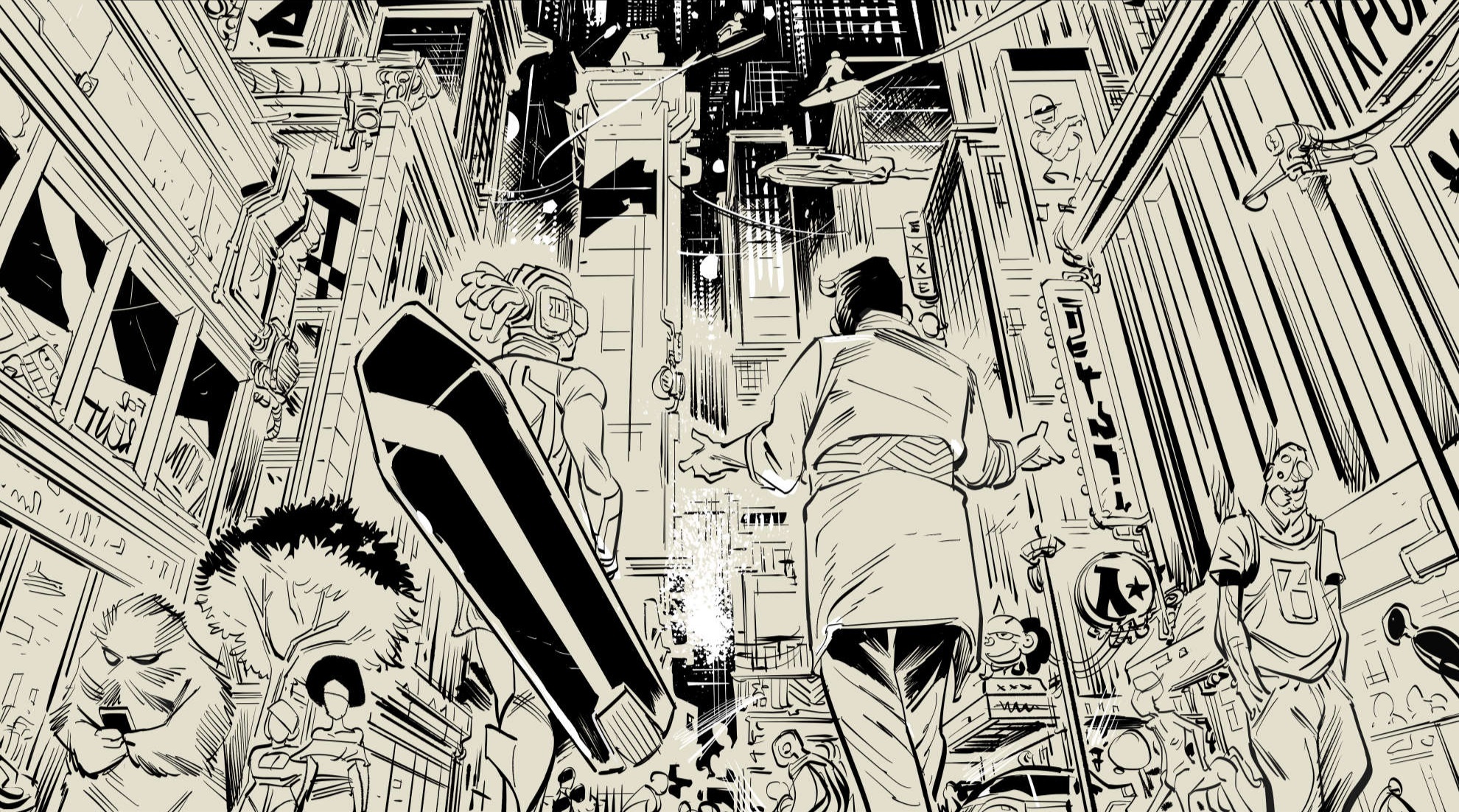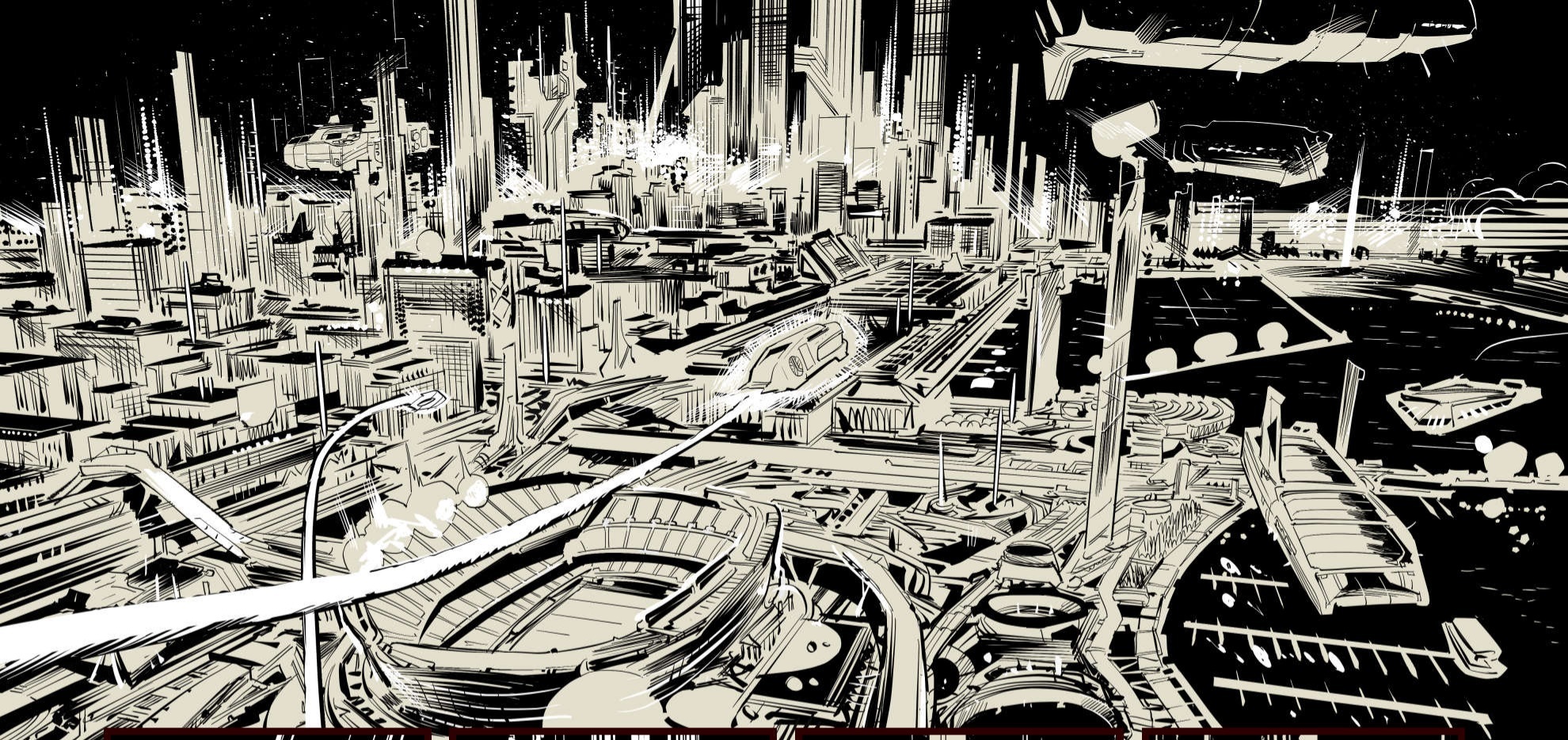
Former NFL Star Lance Briggs Wants to Change the World … With Comic Books
His upcoming graphic novel The Trap tackles issues of systemic racism and inequality in a maybe-not-so-surprising format
Illustrations by Jessica Bromer and Danilo Beyruth
As a society, we’re in the midst of a redefinition of what it means to be “smart.” The dehumanizing effects of relentless algorithmic optimization and data-driven thinking have brought into sharp relief the value of emotional intelligence (commonly referred to as “EQ”) as a key leadership skill and a springboard to not only individual success, but collective success as well.
With an eye toward this welcome sea change, we’ve partnered with our friends at Lexus on a series of interviews with inspiring individuals who are forging new paths and leading their respective industries with empathy and EQ at the forefront of their work.
Today’s subject: former NFL linebacker Lance Briggs, whose 12 seasons with the Chicago Bears yielded 1,173 tackles, seven Pro-Bowl appearances and three All-Pro selections. After retiring in 2015, Briggs began focusing his efforts on another lifelong passion: comic books. An avid reader since childhood, Briggs eventually connected with Kyle Higgins, the acclaimed comic book writer and filmmaker whose credits include everything from Captain America to Batman to Mighty Morphin’ Power Rangers.
The fruit of their collaborative efforts is The Trap, a science-fiction graphic novel inspired by Briggs’ upbringing in Sacramento and the hardship he witnessed there. Funded on Kickstarter and set to be released this August, The Trap tells the story of a promising young athlete “from a not-so-great part of the galaxy” whose chance at a better life is thrown into peril by a tragic mistake — a narrative meant to, according to Briggs, “show people that the lives of the economically and marginally oppressed are just as valid as their own.” We sat down with him (virtually, of course) to discuss his obsession with comics, the process of translating his life into one, and the larger goal of shining a light on societal issues via art.
InsideHook: What was it that drew you to comic books as a kid?
Lance Briggs: I think imagination. My mom was looking after her three kids as a single mom and she had to go to work every day. So there were a lot of rules that we had when she was away from the home to make sure that we were going to be safe. I think imagination was one of those things where it allowed me to just go wherever I wanted to go. There was no place I couldn’t go with my imagination and comics were an extension of that. When I first started reading comics, it was just like, “Wow. I feel like there are no limits here.” That’s really what drew me to comics and I’ve been addicted ever since. I thought maybe I’d grow out of it, but it’s been just the opposite.
Were there stories that you connected with particularly on an emotional level?
Well, as a teen as I was getting a little older, a lot of the relationships were attractive in a lot of ways. Seeing some love interests. It was kind of like your comic daytime soap opera where you just really get caught up in the relationships as opposed to the crime fighting or the battles and everything else going on. Gambit was a popular character for me and he had a relationship with Rogue. Then I see Rogue with Magneto and I’m like “How is this happening? I thought you two were in love!”
An early introduction to the complexity of modern relationships!
[laughs] Absolutely. Absolutely.
Was there a catalytic moment when you knew that you wanted to tell this sort of allegorical story about where you come from in this format?
I’ve always wanted to be a part of comics, I just never knew that I could in the way I wanted to be. Really it was kind of by chance — at that time, my publicist asked, “What are the things that you love to do?” I said, “Well, I love comics.” She started reaching out and getting a really good response. Once I was in front of the comic community, of course I was questioned. I was grilled a bit on my knowledge to see if I knew what I was talking about, which was fine. I mean, I would do that to anybody who was coming onto the football field. I want to know if you really know what you’re talking about or if you’re blowing smoke. But it worked out and I was able to write my first comic, the first and only issue of Seraph, and then I met Kyle Higgins.
He took me to tour the DC offices in Southern California. We sat down in a coffee shop, went over ideas — I actually had a large notebook with me — and we went over ideas and found one that stuck. The one that stuck was really nearest and dearest to my upbringing. And not just my upbringing, but so many others that I had either witnessed or had experience with growing up. So it’s definitely loosely based on my history, but it’s based on so many more as well.
I feel like personal history is just such rich emotional territory to mine for storytelling.
Yeah, it is emotional. When I started talking about growing up, I was telling Kyle that me successfully making it to the professional ranks of football doesn’t change the situation for those that were like me growing up in those neighborhoods. I’m more of an exception to the rule than what the rule states. So the story is really about what you have to deal with, what each one of those kids and their families and everyone in those communities has to deal with. It’s the community that has to rally around the kids and protect them when they feel like the system has failed.

It’s very interesting that you say that you making it to the ranks of professional football doesn’t change the situation for other people who are facing that situation, but now you’re in a position where telling this story can be ultimately a catalyst for some sort of change. Do you view this project through that lens?
Absolutely. I’ve tried in a lot of different ways throughout my career to reach back and give, especially to less fortunate kids. Whether through holiday gift giveaways or rewarding kids for grades and attendance, football camps in three different states, visiting schools. But what I realized is there are so many different ways to reach people. I believe that this is project is another way a lot of kids can relate and it’s a fun way to read. It’s a fun way to connect with someone you can relate to. I always want to send a message to the kids that I’m just like them.
I had a conversation not too long ago about a character. The premise and everything was really good. This character was from a rough neighborhood, let’s say from the Bronx, New York. The Bronx deserves a real voice. There’s things that happened in the history of the Bronx and they’re happening today that the folks from that area will really connect with. I grew up in Sacramento, California, so I know what it’s like to grow up in that area. I may not have grown up in the Bronx, but as far as certain communities go from hood to hood, there are certain things that are already understood. In storytelling, I think each one of these communities deserves its own voice, deserves a real voice to do it justice.
Sponsor Spotlight
How Do You Design a Truly Empathetic Driving Experience?
Just as visionary leaders understand the importance of emotional intelligence in forging new paths, Lexus understands its importance in the world of automotive design. As they’re fond of saying, “When you design around pure technology, the result is a leading-edge automobile. When you also design around humanity, the result is a Lexus.”
This focus on emotional understanding and human-centered craftsmanship is abundantly evident in the brand’s new flagship LS, a new standard in luxury autos that seeks to create a deeper connection between driver and car to deliver a truly empathetic driving experience.
The brand’s dedicated Takumi master craftsmen (of which there are only 19 in the world) have leveraged their unparalleled skill to make each element of the LS a truly human experience. Interiors offer beauty beyond function, with Kiriko cut-glass panels and hand-pleated trims inspired by the art of origami. Connected technology including a new touchscreen multimedia display and Alexa connectivity, is focused on maximizing productivity while minimizing distraction. And features like Climate Concierge and multifunction massage seats are engineered for new levels of physical comfort.
Which is to say nothing of the LS’s top-shelf drive performance, with reduced vibration and adaptive variable air suspension for the definition of a smooth ride.
The result: when you get behind the wheel, you’re not just getting from A to B — you’re experiencing thousands of hours of labor dedicated to making you feel understood.
I’d like to talk a little bit about emotional intelligence as it relates to collaboration. You’ve had to collaborate as part of a team both on the football field as well as now in the world of comics. Are there similarities there?
I think football teaches you a lot of things. You get to the professional level, or any level really, there’s ego. There’s a battle of wits. You get on the field, you see somebody that plays well. You believe you’re better than them and you compete. Next thing you know, you guys are on the same team. You have to learn how to work together. You got to know that there’s a role that you have to play. If both of you are equally talented but one of you gets more airtime, gets interviewed more, is just a more popular guy, that isn’t a fault of yours or his. Really it’s about understanding roles, in my opinion.
In the field of comics I always view myself as the newbie. I’m the new guy and I really enjoy the grind. I enjoy the criticisms that I know to expect from Kyle. This is Kyle’s profession. This is what Kyle does. So when we sit down and we collaborate … I’ll give you a great example. When we sat down at that coffee shop in Hollywood and started talking ideas, I told you earlier I had a big notebook and I had all of these ideas. We started looking through these ideas and Kyle was like, “No. Mm-mm. Nah, I’m not really feeling that one. I’m not feeling that one either.”
We went through four or five ideas and then we just started talking about life. He was talking about his life, I was talking about mine, and it really kind of hit when I told him, “In the hood, we always called it ‘The Trap,’ because you’re not meant to get out of it.” He perked up like, “Whoa. That’s gripping.” So when you talk about collaborating, everything started from that moment. It wasn’t me writing down my ideas for what I thought would be great. It was just the both of us talking. This story is certainly based on my history and my knowledge, but the structure of it certainly has Kyle’s expertise on it. So in collaborating, I get to see from an angle that I wasn’t looking at and he gets to see it from an angle that he wasn’t looking at. So it’s really cool when we put the angles together.

Does the idea of a “superhero” mean something different to you now than it did when you were a kid?
Yeah. When I was a kid, all I saw was the good guy and bad guy. Traditionally, the bad guy has gotten a really bad rap because the reader didn’t try to understand what the bad guy had to go through to become the bad guy. Today, I don’t think that there’s just a traditional good guy and a traditional bad guy. I think there are bad guys that you get on board with because you relate a lot more [to their journey]. There are good guys that you relate to because they’re so flawed. Right now, I think it’s less about the actual good guy and the bad guy, and more about the good decision versus the bad decision.
To piggyback off of that, you’ve said that this narrative is about making mistakes and the need for second chances. What is it about those ideas that resonate so much for you?
In the hood it’s everybody is one mistake away from completely losing their life. Sometimes, the difference between a kid in the hood versus a kid from the burbs or an affluent kid is the ability to have a good attorney represent you in the court system. A kid that has money, they can bring an attorney in and the case is thrown out. The poor kid could commit the same crime, can’t afford an attorney, gets all these charges slapped on him and then finds himself out of school, in juvie and going into the jail system.
You see these things happen to some of these young kids that could have such a promising career. You get to the professional ranks and you start talking to a lot of these professionals — a lot of these guys that have made it, Hall of Famers, they all have a story. In any sport, they all have a story of somebody they knew that was as good or maybe even better than them that didn’t make it. They got caught up in the trap.

I feel like a lot of people don’t realize that comic books have a really long history of telling stories that are allegorical for larger societal issues like this. For example, X-Men dealing with civil rights. What is it about the format that you think makes it so effective in that way?
I think it draws back some of the offensive layers or defensive layers between cultures and races. You’re able to tell a story and that story could be related to the pandemic or it could be related to race relations. People will dive into it and think it’s a great story and follow it and understand it. Then when they ask, “Well, where did the inspiration come from?” “Well, it came from the George Floyd case, the divide in our country.” Then you’ll have the reader sit back and go, “Huh. Okay.” And they start to think. It can be thought-provoking in that way. I think it’s a creative way of taking current, past or future issues and positioning them so that each reader is open to experiencing them.
There’s a sneaky way of getting the reader to buy into the main character. In The Trap, the main character is a really good-hearted kid that has had a turbulent upbringing and he’s got himself to where he’s basically the next big thing on planet Earth. Then he makes a mistake and someone loses their life. If you follow the story, as a reader, you don’t want that to be the end for him. You know that he didn’t mean for it to happen. The viewer tends to empathize with the main character once they are able to understand their story and understand where they come from. Then the story starts to really unfold in the viewer’s favor. It’s less about where you’re from and it’s more about seeing this character through to the end.
So it’s giving the reader that context to understand — even if you didn’t come from a marginalized upbringing — how this stuff can happen to good people. Would you say that that’s the most important message that you’re hoping the audience takes away from the book?
Exactly, it can happen to anyone, and under these circumstances, the chances of someone losing their life, the percentages are a lot higher. Something like this is more likely to happen. It’s such a thin line for a lot of these youngsters growing up because their parents, their communities, they’re always worried. I mean, every parent is worried, of course, but moreso in these areas. You’ve got to worry about who they’re with. You’ve got to worry about the cops. You have to worry about someone claiming they did this or they did that. You’ve got to worry about addiction. There are so many worries and you know that just one bad decision, a decision that might not have even been their own, could cost them their lives.
It strikes me as a very empathetic pursuit, to shine a light on issues like this via art. Is there anything specific to which you would attribute that empathy?
I like to hope that I am empathetic. I just know that the kids are our future and I know how hard it was for me. I had a mom who, with everything that she did work-wise, was there for her kids. She supported her kids. There was so much joy that she had when she was able to live through her kids, and every kid that I grew up with didn’t have a mom like mine. If you don’t have a mom like mine or similar to a mom like mine, there’s a good chance you’re not going to make it. There’s a lot that goes into this but I think there is so much talent. There are so many gifted kids in our country that we’ll never hear about. We’ll never know their names.
You look at these sports. You look at football, baseball, basketball. They’re three sports where you see a lot of minorities in them because those sports don’t cost much. They’re cheap sports. But, if given the opportunity in hockey, in NASCAR, in tennis? Minorities in our country would thrive in these if given a real opportunity. Even outside of sports — in writing, in comics, in movies. I think our country owes it to its own to see that children succeed.
The Charge will help you move better, think clearer and stay in the game longer. Subscribe to our wellness newsletter today.





